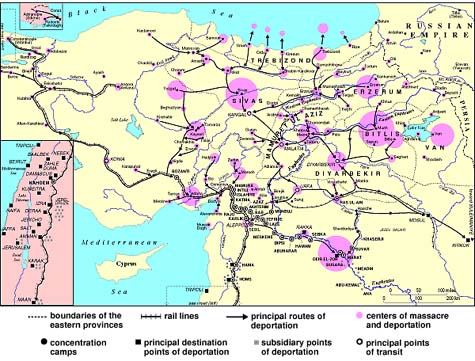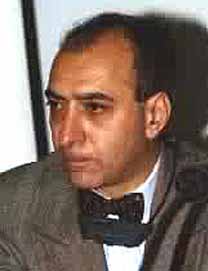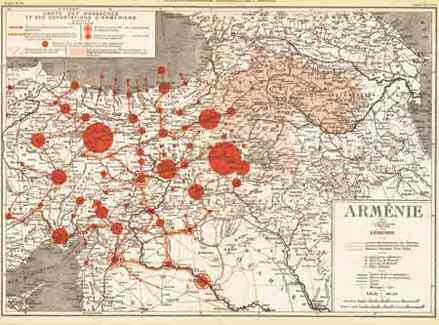|
|
It's not the first time Ara
Sarafian had locked horns with ANI (The Armenian National Institute), with its
director, Rouben P. Adalian (as may be seen here). The following is from an unspecified issue of Armenian
Forum.
It takes courage for Ara Sarafian to make a conclusion such as "For
the ANI, an organization with an academic director, an academic board, and a
substantial endowment, there can be no excuse for such shoddy, incompetent
work," particularly since the last time (or, as the last time went
over similar issues, this episode might have been an extension of the last
one), Dr. Adalian practically accused Sarafian of being an "agent of the
Turkish government" (Adalian accused Sarafian of having "ulterior
motives") were for even giving the impression of breaking ranks with
Armenian claims. Generally, there can be no disagreement with whatever
propagandistic claim that is made; in fact, too many Armenian extremists feel
the more wild the claim, the greater the display of patriotism for Hai Tahd,
or the Armenian Cause. Since the whole foundation of "Armenian genocide
scholarship" is shamelessly corrupt, it is almost amusing that ANI is
being called on for its dishonesty. But since the "caller" is a
fellow (yet milder) propagandist, once again, Ara Sarafian deserves a lot of
credit. (But that doesn't mean Mr. Sarafian is off the hook with some of his
own claims. A brief look follows.)
|
|
|
| Icons
and Scholarship |
Under Review
Armenian National Institute
The 1915 Armenian Genocide in the Turkish Empire
Washington D.C. 1998
Zadig Khanzadian’s map, Rapport sur l’unité géographique de I’Armenié: Atlas
historique (Paris, 1920), has become a central icon of the Armenian Genocide. It was
the first attempt to map out the losses of the Genocide, the principal deportation and
transit routes, and locations where mass killings had taken place between 1915 and 1917.
It illustrated losses in red circles that varied in size according to the populations in
question. Given that Khanzadian’s map was printed in 1920, immediately after the
cataclysm of 1915, and under very trying circumstances, it is not surprising that many
details were left ambiguous, presumably because of a lack of information.[1] Despite its imperfections, the 1920 work was of pioneering significance
and remains a milestone in the historiography of the Armenian Genocide.
Some eighty years after the publication of Khanzadian’s work, the Armenian National
Institute (ANI) has also produced a map of the Armenian Genocide. This new map purports to
be the “latest research” on the Armenian Genocide, and an example of the ANI’s
commitment to the “promotion of scholarship.“[2]
Though the ANI could have drawn on a great deal of new scholarship for such a map, their
“latest research,, is simply an English version of Khanzadian’s 1920 work, combined
with a more recent publication by Raymond Kévorkian, "Axes de déportation des
populations arméniennes et camps de concentration en 1915-1916.“[3] This fact is obscured by a curious citation, where credit is given to
“the Armenian National Institute (ANI) (Washington, DC) and the Nubarian Library
(Paris)," and there is no mention of Khanzadian and Kévorkian.[4]
Beyond obscuring the intellectual origins of the work under review, the ANI does a
disservice to scholars of the Genocide by ignoring their work in its representation of the
“latest research" on the Genocide. Furthermore, instead of correcting the errors
and ambiguities of Khanzadian’s map, the ANI reproduces them and introduces new errors
that should have been avoided. Here are some examples:
|

A few different maps were
presented with the article; the above map, ubiquitous in too many genocide web sites,
is more or less what we are talking about. The last photograph in the article was, in
a sense, the most revealing. Its caption read, "This image from the ANI Annual
Report for 1998 shows ANI director Rouben P. Adalian, Ph.D., exhibiting the map under
review to a group of schoolchildren." This shot was yet another example of
how propagandists work on poisoning the minds of impressionable children with genocide
hatred, ensuring that the cycle of young recruits will always be kept refreshed, to
fight for the "cause."
|
|

|
|
Dr. Rouben Adalian at a
2005
genocide conference in Yerevan.
Possession of a Ph.D. and a
commitment to truth are not
necessarily related.
|
(1) The ANI map fails to address the most basic
of questions regarding the Khanzadian map that it reproduces: What do the red
circles in the 1920 work actually represent? Do they indicate the number of people
killed at each locality, or the number of people from each locality
who were killed?
Today we have a good understanding of the number of Armenians living in the Ottoman
Empire on the eve of World War I, as well as compelling figures regarding how many
were killed in Der Zor and other locations.[5]
Kévorkian, for example, argues that 870,000 Armenians actually arrived in Syria and
Mesopotamia by the end of 1916, and most were killed in the lower Euphrates. The
body of Western archival records also supports these figures, clearly shifting the
focus of genocidal killings to the south.
As the ANI map stands, the circle at Der Zor is too large if it represents the
number of Armenians native to that region killed in the Armenian Genocide (there
were fewer than 500 Armenians in 1914), and it is too small if it represents the
number of people from other parts of the Ottoman Empire who were killed in Der Zor
and surrounding areas (over 300,000).[6]
(2) Today we know more about the events of 1915 than ever before. For example, there
is a creditable doctoral dissertation on the manifestation of the Armenian Genocide
in Trebizond. [7] We know, for example, that in
1915, there were approximately 5,500 Armenians there. When deportation orders were
first announced, a large number of Armenian children were placed into orphanages and
later disbursed in Muslim villages.[8] The adult
population was deported in four caravans on 1 July 1915 (600 people); 3 July 1915
(2,000 people); 5 July 1915 (2,000 people); and 18 July 1915 (remaining population).[9]
There was, it is true, a report of the mass drowning of ten thousand Armenians from
Trebizond in the Black Sea. The New York Times wrote on 7 October 1915 that James
Bryce reported that the Italian consul at Trebizond had claimed that ten thousand
Armenians had been drowned in one afternoon. But by 1916 Bryce must not have
considered the report reliable, since he did not include it in the British
Parliamentary Blue Book. [10] Nevertheless, the
ANI map includes mass drownings in the Black Sea in its representation of the
Armenian Genocide.” [11]
|
Raymond Kevorkian
|

|
|
Dr. Raymond
Kévorkian
|
Who is this "Armenian scholar" whom Ara
Sarafian has evidently placed so much of his trust in? An interview
in Aztag Daily, conducted by Katchig Mouradian, sheds some light. (The
interview is in French, and you may need the translator depicted by the flags, under
"Sections" in the navigation bar above, at left.)
The monsieur tells us that "To write the history and to approach the truth
as much as possible are essential for a nation." Well, who can argue with
that? Unfortunately, it is all downhill from there. Kevorkian follows up with, "I
want to say that henceforth it is not a question any more of asking the proof that an
event took place, but to put an end to a need for our national interior health."
In other words, the "genocide" is a done deal, and no evidence is necessary,
unproven as it is; it is the same line of reasoning Richard Hovannisian tried to get away with, in an attempt to
pull the wool over the eyes of people trying to get at the truth.
And how does the professor back up his "scholarly" conclusion that the
genocide is a settled matter? He tells us, "There is no doubt that the
decision to exterminate the Armenians was made from the very start and plays a
personal part in the ideology of the CUP [Ottoman government]," the decision
for extermination having been made by the end of March. That is the timing Taner Akcam
strove for as well, and here is the peculiar
way in which he fared with his "proof." We don't know the evidence
Kevorkian offers; with the interview, he simply tells us that this is the fact.
Kevorkian actually goes beyond Akcam's mentor, Vahakn Dadrian (who had instructed us that the
"genocide" had "all but run its course by 1916," with the
"completion of the main part" having been done with by January-February of
that year), by telling us that February 1916 actually constituted "the second
phase," when "the decision was made to massacre the deportees."
And this was after 700,000 had already been killed in the eastern provinces,
you see! (Let's do the math, then; you read above that Kevorkian had concluded 870,000
had been resettled by 1916's end, which means — after adding the 700,000 dead — we
are already above the 1.5 million pre-war population figure, and we haven't accounted
for the half-million or so who had already amscrayed
to other lands on their own accord, nor for the 200,000 or so who hadn't been touched
in the major cities of the west. Great scholarship!)
He also tells us, as the good little propagandistic soldier that he is, that the "so-called
revolt" of Van was simply a pretext, and that "what occurred was
not a revolt, but self-defense." (Even Ambassador Morgenthau, not in his
propagandistic "Story" book but in an official communication, wrote that "...It
would seem as if an Armenian insurrection to help the Russians had broken out
at Van." The Parisian newspaper Le Temps, along with so many other
Armenian-friendly sources, concurred.
It can't be self-defense if the first shot was fired by the Armenians!)
Kevorkian backs up Dadrian, stating the executioners were indeed Dadrian's invented
Gestapo, the Special Organization,
and when asked which archival files Kevorkian has given importance to, Kevorkian
stresses the U.S. archives, of which "a gigantic work will soon be published,
prepared by Ara Sarafian." Bear in mind, the British themselves rejected the
American documents while in search of their own "genocide evidence," in
preparation for the Malta Tribunal,
concluding that they were comprised mainly of "personal opinions," that is, hearsay,
and worthless as genuine evidence.
Next, Kevorkian lists the importance of the German, Austrian, French and British
files. But, of course, how can one write valid history about a nation by ignoring the
archives of the studied nation, and by giving prominence to the nations who were
either the enemies of the studied nation, or who had harbored centuries-old prejudice
against the studied nation? So it is up to the interviewer to remind Kevorkian, "But
what is it possible to say in connection with the Turkish files?" Kevorkian
basically replies that these are worthless. He points to "testimonies" that
the CUP had either sent the genocidal documents to Ankara during "the last
weeks of the war," or "completely destroyed" them. Yes,
surely the discombobulated Ottoman leaders had such a priority in mind in the five
minutes it took for the British to come in and occupy the nation.
Kevorkian also points to the puppet Ottoman government's 1919-20 courts-martial, the
ones that constitute Dadrian's bed and butter; of these, Kevorkian tells us the
documents were mainly gathered with the Patriarch, in a "sector of a special
office which was called Center of Information," the person in charge being
Archag Alboyadjian. The Patriarch Zaven ordered these materials to be moved out
in anticipation of the arrival of Ataturk's forces, and so "These documents
were transported to Manchester, then to Marseilles and finally to Jerusalem. All these
files, of which very few people are well-informed, are extremely important because
they are Turkish and authenticated sources." Yes, they are also the files of
the trials that the British regarded as a "farce," and as a travesty of
justice, and rejected in
preparation of Malta.
Again, it is much to Sarafian's credit to point to the mediocrity of Rouben Adalian as
a scholar; so why is Sarafian attaching such importance to the work of Kevorkian the
Komedian?
|
(3) Many Armenians from western Turkey were deported toward Syria by train in cattle
trucks. They had to disembark and trek over the Taurus mountains because the railroad was
not finished. Many died on the way. Other deportees, thousands of them, were used as
forced labor to complete these incomplete sections of the railway. [12] The ANI map shows the railroads as continuous. In the map, the
railroad extends several hundred miles to the east of Ras-ul-Ain (where it actually ended
in 1915). This information is correct in Khanzadian’s 1920 work, but not in the ANI map
of 1998
The publication of the ANI map raises questions about the competence of the ANI as an
academic institution. Publications in Armenians studies need to be held to the highest
academic standards. The ANI map, sad to say, does not even meet the most forgiving
standards. For the ANI, an organization with an academic director, an academic board, and
a substantial endowment, there can be no excuse for such shoddy, incompetent work.
Ara Sarafian
|

This is the 1920 map by Khanzadian and Aram
Andonian. Note that it
goes halfway into Turkey and it is called "Armenia," far beyond the borders
of the actual Armenia that was established in 1918. Note in Footnote 1
below that Ara Sarafian agrees the region above "was limited to Armenia."
|
1. The work was also used to buttress the
position of the Armenian National Delegation, which claimed sovereignty over much of
western Armenia in the former Ottoman Empire as a final home-land for survivors of
the Armenian Genocide. Khanzadian’s map did not show the whole of the Ottoman
Empire when representing the Genocide. It excluded, for example, the communities of
Boursa, Izmid, and Adabazar. It was limited to Armenia.
2. This claim is made in the ANI Annual
Report, 1998.
3. See Revue d’histoire arménienne
contemporain (numero spécial): l’extermination des déportés arméniens ottomans
dans les camps de concentration de syrie-méspotamie (1915-1916): la deuxiéme phase
du génocide (Paris, 1998), pp. 48-49. This work shows the 1915-16 deportation
routes, especially the concentration and extermination camps in the lower Euphrates.
4. The fact that the ANI lifted The 1915
Armenian Genocide in the Turkish Empire from the works of Zadig Khanzadian and
Raymond Kévorkian is confirmed by the ANI Web site, which mentions the two
scholars, but still does not give bibliographic information, including the date of
Khanzadian’s work. One is still left with the impression that the ANI map is of
recent origin, reflecting the latest research on the Armenian Genocide.
5. For population figures see Raymond
Kévorkian and Paul Paboudjian, Les arméniens dans I’empire ottoman à la
veille du genocide, (Paris: ARHIS, 1992). In fact, the article that accompanies
the Kévorkian map that the ANI has utilized discusses the number of Armenians who
perished in Der Zor in great detail. See “Axes de deportation des populations
arméniennes et camps de concentration en 1915 1916,” pp. 60-61.
6. At the beginning of 1916, United States
consul Jesse B. Jackson estimated that there were 486,000 Armenians in the lower
Euphrates, over 300,000 of them in Der Zor and surrounding villages. See J. B.
Jackson to Ambassador Morgenthau, communication dated Aleppo, 8 Feb. 1916, National
Archives, General Records of the Department of State, Record Group 59, Internal
Affairs of Turkey, 1910-1929, Decimal file number 867.48/271. None of these survived
by 1918.
7. Kevork Suakjian, “Genocide in Trebizond:
A Case Study of Arrneno-Turkish Relations During the First World War,” (Ph..D.
diss., Univ. of Nebraska, Lincoln, 1981).
8. For example, see the memoirs of Leo [sic]
Surmelian, who was placed in a caravan of children, marched south, and placed into a
Muslim family. Some of his fellow children were killed outright because they could
not keep up with the convoy. Surmelian, I Ask You Ladies and Gentlemen (New
York: EP Dutton, 1945).
9. Suakjian, “Genocide in Trebizond,” pp.
132-36. lo
10. James Bryce and Arnold Toynbee, The
Treatment of Armenians in the Ottoman Empire, 1915-1916: Documents Presented to
Viscount Grey of Fallodon by Viscount Bryce [Uncensored Edition], ed. and intro.
Ara Sarafian (Princeton, N. J.: Gomidas Institute, 2000).
11. A microfilm collection assembled by
none other than the ANI’s director includes the dispatches of Oscar Heizer, United
States consul in Trebizond, 1915. These dispatches also do not support the reported
mass drowning. See National Archives, General Records of the Department of State,
Record Group 59, internal Affairs of Turkey, 1910-1929, decimal files 867.4016/94,
103, 114, 128, 210, 224.
12. See Hilmar Kaiser, “The Baghdad
Railway and the Armenian Genocide, 1915-1916: A Case Study in German Resistance and
Complicity,” in Remembrance and Denial: The Case of the Armenian Genocide,
ed. R. G. Hovannisian (Detroit: Wayne State Univ. Press, 1999), pp. 67-112.
|
| Holdwater's
Thoughts |
Again, we are grateful for Ara Sarafian to have had the guts to
perform the very rare feat of pointing out the holes of his fellow propagandists. This is
why it's all the more heartbreaking when Mr. Sarafian lapses into his own encounters with
the absurd.
We'll just point to a couple of examples, as the idea of this page is not to dissect Ara
Sarafian, but to display the dishonesty of Armenian propaganda in general.
Mr. Sarafian already blew his credibility when he tried to legitimize Bryce and Toynbee's Wellington House product, the hateful Blue Book... the accounts of which (as Arnold
Toynbee himself had written) almost entirely came from Armenians and their missionary
allies. (As though this blatant propaganda should ever substitute for genuine history;
Sarafian tried to breathe new life into this work by uncovering the identities of some of
the anonymous sources, as if such would have made their statements any more legitimate.)
But look at what he says here:
"Kévorkian, for example, argues that 870,000 Armenians actually arrived in Syria
and Mesopotamia by the end of 1916, and most were killed in the lower Euphrates. The. body
of Western archival records also supports these figures..."
It is possible that so many Armenians were resettled, although it's hard to say.
"Western archival records" relied on the word of Armenians and missionaries, not
exactly what an objective researcher would point to as reliable information, given the
tendency for both parties to "exaggerate." Boghos Nubar, as one example of a source in disagreement, guessed the total
to figure in the vicinity of 600,000-700,000, in a letter to a French minister at the end
of 1918.
But the eyebrow-raiser is the claim that "most" of these nearly 900,000 were
killed. That is a stupefying falsehood. What the body of Western archival figures
actually supports is that the pre-war
Ottoman-Armenian population hovered near 1.5 million, and even today's worst propagandists
concede one million survived. If one does the subtraction, it would be impossible for,
say, around 800,000 to have died. If we add the other Ottoman-Armenians who died from
other years, that would mean two-thirds of the original population would have been killed,
instead of one-third, leaving around half a million alive.
Yet what is most irritating, as Sarafian explains in Footnote 6, is that J. B. Jackson's estimate of 486,000 living and resettled
Armenians by early 1916 all had died! That's right, Sarafian actually tells us "None
of these survived by 1918," as if there could possibly be any way to verify such
a claim. Is it any wonder that after being barraged by such propaganda at the time these
events were taking place, Admiral Colby Chester referred
to the many survivors as, "In due course of time the deportees, entirely
unmassacred and fat and prosperous, returned (if they wished so to do), and an English
prisoner of war who was in one of the vacated towns after it had been repopulated told me
that he found it filled with these astonishing living ghosts." Lt. General Sir W.
N. Congreve concurred in 1919: "... I did
not see a thin one amongst a good many thousand I saw, and most looked cheery too. The
massacres seem to have been a good deal exaggerated ..."
If most of the resettled did not survive, there is no way one million could have survived
from an original population of 1.5 million, and it is sickening for anyone to claim
"none" could have survived out of hundreds of thousands. If we really want to
get to the bottom of the bulk of the Armenians who had died, it wasn't from the ones who
were resettled (not to say too many didn't suffer or die from the awful relocation
process), but from the ones who had stayed behind in Eastern Anatolia, committing a
massive slaughter upon the remaining Ottoman Muslims and Jews. When the tables turned, a
lot were murdered in turn, out of revenge, during this inhuman time. We also know from
what Richard Hovannisian wrote in 1967 that nearly 150,000 of the non-resettled Armenians
died from famine and disease, while accompanying the Russian retreats. (In addition,
thousands similarly died while accompanying the French retreat, after the war.) 150,000 is
an entire quarter or more out of the 500,000-600,0000 Armenians who died in all. It is
only common sense that it would have been impossible for all of the 486,000 that Consul
Jackson estimated to have perished. Why would Ara Sarafian tell us such a thing, following
in the footsteps of a shameless windbag such as Vahakn Dadrian?
I also did a double take with Sarafian's claim (Footnote 8) that Leon Surmelian had
indicated "children were killed outright because they could not keep up with the
convoy." I don't have the book handy to check, but I made certain at the time to record the worst of what Surmelian had written,
and as far as "witnessed murders" were concerned, there was a case of one woman
who was presumably killed (in the memoirs, no one actually saw the presumed murder; they
only heard a rifle shot). It's possible I might have missed something, but even if
Surmelian wrote about kids getting killed as well, are we supposed to take the word of one
who was eight-years-old at the time, and who grew up to be an "exaggerating"
patriot in his own right? (One of the more amusing examples of "genocidal proof"
in Surmelian's book was that the mean kids of the Trabzon governor, whom Surmelian was
playing with, told young Surmelian that the Armenian child would be marked for death.)
Even if there were lowlife gendarmes (and there certainly were a good few), are we
supposed to take from the crimes some may have committed that they were following a state
policy? If they were, to cite Sarafian's own words, "None of these [could have]
survived by 1918." It would be absolutely ridiculous to think otherwise! (And
what of other examples of "Armenian oral history" telling us of a different,
non-murderous fate that awaited those who could not go on, such as this one?)
Regarding the famous "genocide map" criticized above, there
is a Gomidas page (http://www.gomidas.org/books/map2.htm) where (very likely) Ara Sarafian
wrote that the map "was primarily the work of engineer-cartographer Zadig
Khanzadian and Aram Andonian, probably the
foremost expert on the Armenian Genocide at that time." In other words, this
infamously dishonest man, who created such obscene evil with his forgeries, has now been
assigned the role of a kind of valid historian. And by, probably, none other than Ara
Sarafian himself. It's nothing less than horrifying. (At least we know, if Andonian had a
hand in the creation of the famous "genocide map," how reliable it really is.)
|
|